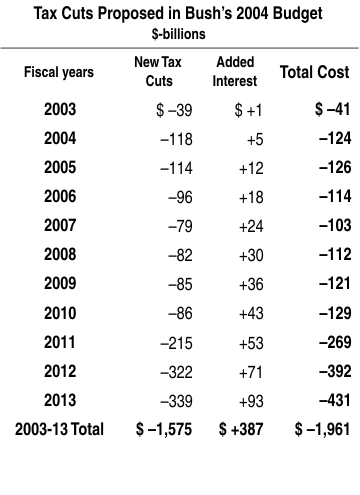March 18, 2003 05:15 PM | Permalink | 
According to the latest figures from the congressional Joint Committee on Taxation, President Bush’s fiscal 2004 budget includes $1.6 trillion in additional tax cuts over the upcoming decade. Counting the $0.4 trillion in added interest on the national debt that the tax cuts will entail, the total cost over the fiscal 2003-13 period will be almost $2 trillion if the plan is adopted by Congress—$100 billion more than the administration previously estimated.

In comparison, the Bush tax cut plan enacted in 2001 was projected to cost $1.6 trillion over its first decade including interest.
In the current fiscal year, the Joint Committee data show that the President’s new tax cut plan will cost $41 billion, thus providing virtually no stimulus to our ailing economy. But by fiscal 2013, Bush’s new tax cut proposals will cost $431 billion a year including interest.
“If the President’s new tax cuts are enacted, it appears that our national debt will approach $10 trillion by the end of 2013, counting the amount owed to the Social Security trust fund,” said Robert S. McIntyre, director of Citizens for Tax Justice.
When Bush took office, the national debt, including the amount owed to Social Security, was $4.5 trillion and headed sharply down. But Bush’s new budget projects a $7.5 trillion debt by the end of 2008, including amounts owed to Social Security. The President refuses to offer an estimate for the size of the debt a decade from now, but the likely figure under the President policies is close to $10 trillion.
“So much for the President’s worthless promise not to send the bill for his irresponsible tax-cutting program to our children,” McIntyre said.
Click here to see this analysis in PDF format.
![]()




